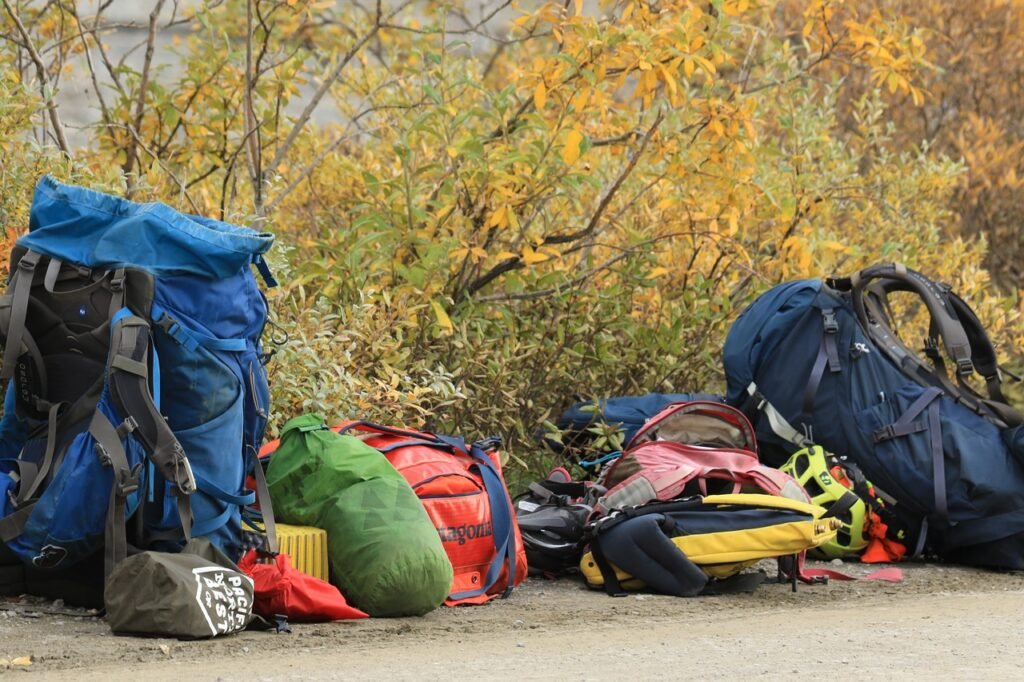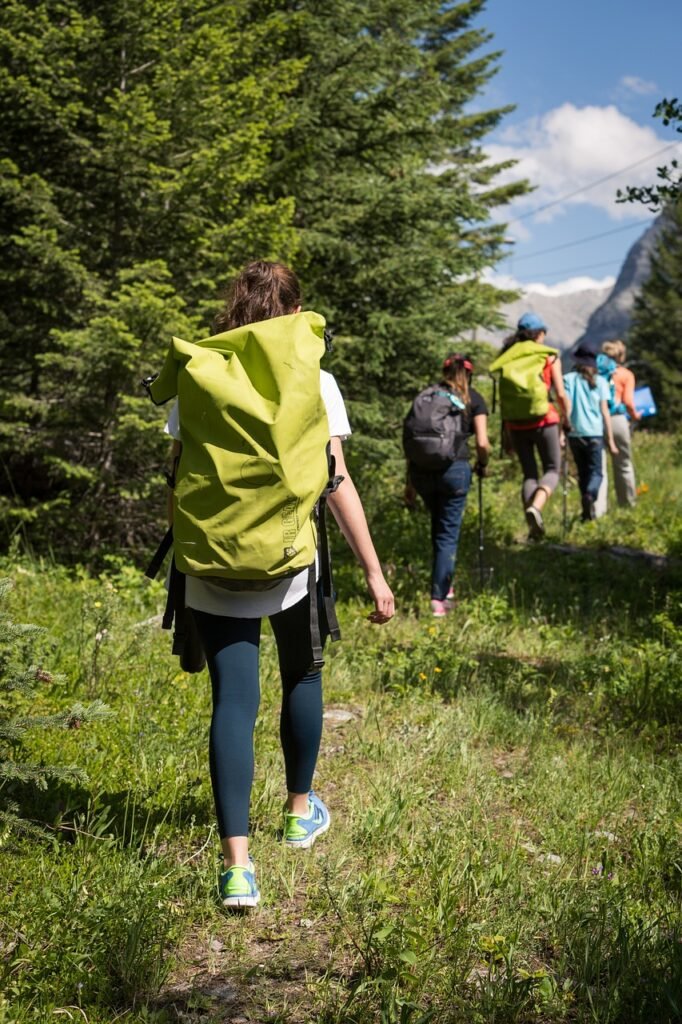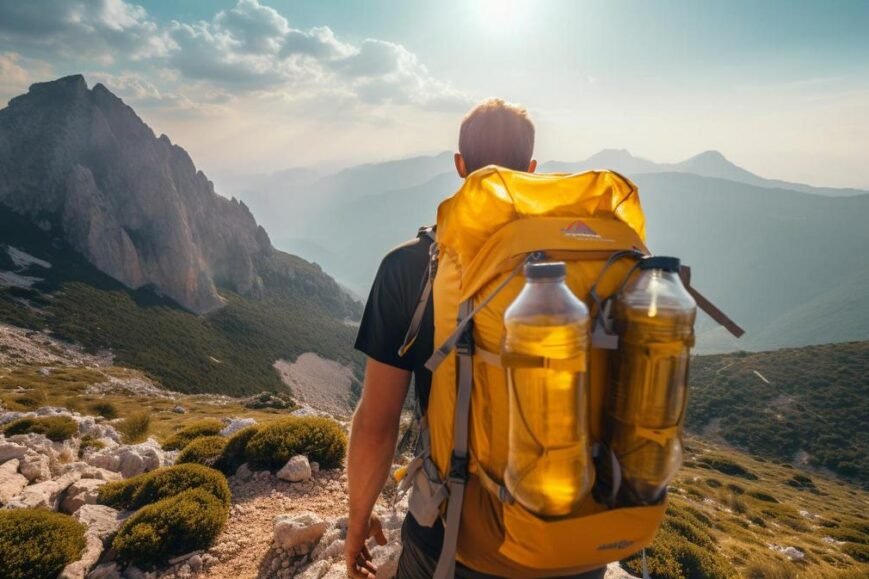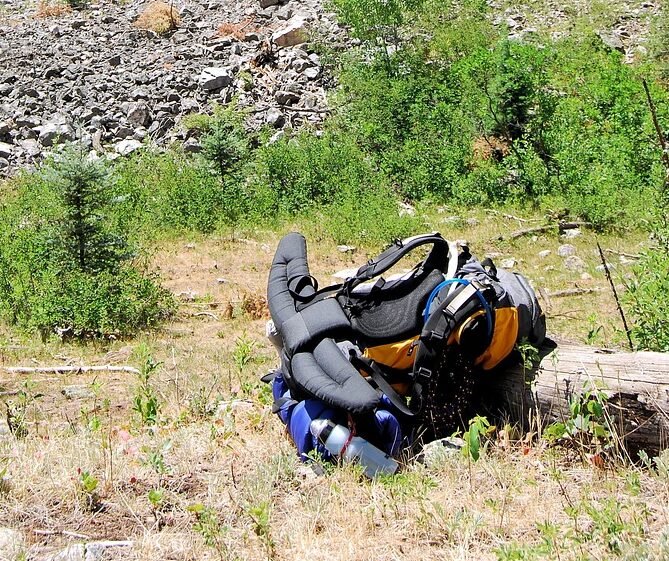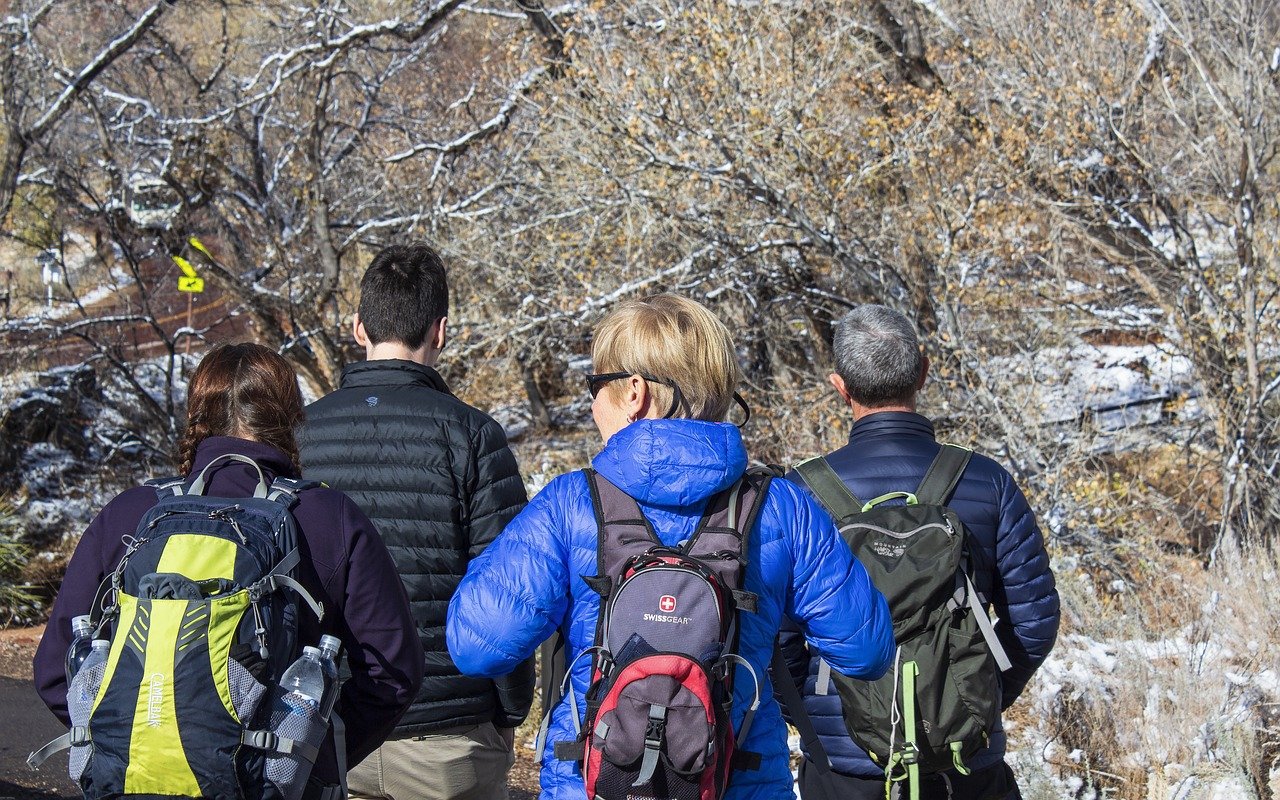Choosing the right hiking daypack can make or break your outdoor adventure. With so many options on the market, it’s essential to find a pack that suits your needs in terms of comfort, capacity, and features. Below, we’ve compiled a guide to What we feel are honestly the best daypacks for hiking in 2024, that you can easily get your hands on.
The NEMO Resolve 35L Backpack is designed to meet the needs of hikers who require a bit more space for their gear. Below, we provide a detailed pros and cons list to help you understand the strengths and weaknesses of this backpack.
The Resolve 35L offers a spacious and durable option for hikers who need extra capacity and advanced features. While it comes with a few drawbacks, such as its heavier weight and higher price point, the benefits of comfort, organization, and durability make it a strong contender for serious hikers. Consider your specific needs and preferences to determine if this backpack is the right fit for your outdoor adventures.
What We Like
- Spacious Capacity: With a 35-liter capacity, this backpack offers ample space for carrying extra layers, food, and gear, making it ideal for longer day hikes or overnight trips.
- Durable Construction: Built with high-quality materials, the NEMO Resolve 35L is designed to withstand the rigors of outdoor adventures, ensuring longevity and reliability.
- Comfortable Suspension System: The backpack features a well-designed suspension system that distributes weight evenly, reducing strain on your back and shoulders during extended hikes.
- Multiple Pockets for Organization: The pack includes various pockets and compartments, allowing you to organize your gear efficiently and access items quickly.
- Hydration Sleeve: The backpack comes with a dedicated hydration sleeve, making it easy to stay hydrated on the go.
- Adjustable Fit: The pack offers adjustable shoulder straps, hip belt, and sternum strap, allowing for a customizable and secure fit.
- Ventilated Back Panel: The ventilated back panel enhances airflow, keeping you cool and comfortable during strenuous hikes.
Our Gripes
- Heavier Weight: Due to its durable construction and larger capacity, the NEMO Resolve 35L is slightly heavier compared to some other daypacks, which might be a consideration for those who prioritize ultralight gear.
- Bulkier Design: The larger capacity and additional features make the pack bulkier, which might not be ideal for shorter hikes or those who prefer a more streamlined design.
- Higher Price Point: The backpack’s high-quality materials and advanced features come at a higher price, which may be a drawback for budget-conscious hikers.
- Limited Color Options: The NEMO Resolve 35L may have fewer color options compared to other brands, which might be a consideration for those who prefer a variety of aesthetic choices.
- Complex Adjustment System: While the adjustable fit is a pro for customization, it can also be a con for those who find the adjustment system complex or time-consuming to set up initially.
The Gregory Jade 24 LT Women’s Daypack is specifically designed to meet the needs of female hikers, offering a blend of comfort, functionality, and style. Below, we provide a detailed pros and cons list to help you understand the strengths and weaknesses of this daypack.
The Jade 24 LT Daypack offers a comfortable and functional option for female hikers, with features tailored specifically to enhance the hiking experience. While it comes with a few drawbacks, such as its limited capacity for longer hikes and higher price point, the benefits of an ergonomic fit, ventilation, and durability make it a strong contender for day hikes. Consider your specific needs and preferences to determine if this daypack is the right fit for your outdoor adventures.

What We Like
- Ergonomic Fit for Women: The Gregory Jade 24 LT is tailored specifically for women, featuring a design that accommodates the female anatomy for enhanced comfort and support.
- Ventilated Back Panel: The pack includes a ventilated back panel, which promotes airflow and helps keep you cool during strenuous hikes.
- 24-Liter Capacity: With a 24-liter capacity, the daypack strikes a balance between carrying capacity and lightweight design, making it suitable for a variety of day hikes.
- Comfortable Suspension System: The backpack features a well-designed suspension system that distributes weight evenly, reducing strain on your back and shoulders.
- Multiple Pockets for Organization: The pack includes various pockets and compartments, allowing you to organize your gear efficiently and access items quickly.
- Hydration Sleeve: The backpack comes with a dedicated hydration sleeve, making it easy to stay hydrated on the go.
- Durable Construction: Built with high-quality materials, the Gregory Jade 24 LT is designed to withstand the rigors of outdoor adventures, ensuring longevity and reliability.
- Adjustable Fit: The pack offers adjustable shoulder straps, hip belt, and sternum strap, allowing for a customizable and secure fit.
Our Gripes
- Limited Capacity for Longer Hikes: While the 24-liter capacity is suitable for day hikes, it may not provide enough space for those who need to carry more gear for longer trips or overnight stays.
- Higher Price Point: The backpack’s high-quality materials and advanced features come at a higher price, which may be a drawback for budget-conscious hikers.
- Heavier Weight Compared to Ultralight Packs: Although the pack is designed for comfort and durability, it is slightly heavier compared to some ultralight daypacks, which might be a consideration for those who prioritize minimal weight.
- Complex Adjustment System: While the adjustable fit is a pro for customization, it can also be a con for those who find the adjustment system complex or time-consuming to set up initially.
- Limited Color Options: The Gregory Jade 24 LT may have fewer color options compared to other brands, which might be a consideration for those who prefer a variety of aesthetic choices.
The Osprey Talon 22 is a versatile and lightweight daypack designed for a variety of outdoor activities, from hiking to cycling. Below, we provide a detailed pros and cons list to help you understand the strengths and weaknesses of this popular daypack.
The Talon 22 offers a lightweight and versatile option for outdoor enthusiasts, with features designed to enhance comfort and functionality. While it comes with a few drawbacks, such as its limited capacity for longer hikes and higher price point, the benefits of ventilation, durability, and multiple attachment points make it a strong contender for day hikes and various outdoor activities. Consider your specific needs and preferences to determine if this daypack is the right fit for your adventures.

What We Like
- Lightweight Design: The Osprey Talon 22 is known for its lightweight construction, making it easy to carry on long hikes or other outdoor activities.
- Versatile Use: This daypack is suitable for a range of activities, including hiking, cycling, and even running, thanks to its streamlined design and multiple attachment points.
- 22-Liter Capacity: With a 22-liter capacity, the pack provides ample space for essentials without being bulky, making it ideal for day hikes and short trips.
- AirScape Back Panel: The pack features Osprey’s AirScape back panel, which enhances ventilation and keeps you cool during strenuous activities.
- BioStretch Harness: The BioStretch harness and hip belt offer a comfortable and secure fit, distributing weight evenly and reducing strain on your back and shoulders.
- Multiple Pockets for Organization: The pack includes various pockets and compartments, allowing you to organize your gear efficiently and access items quickly.
- Hydration Sleeve: The backpack comes with a dedicated hydration sleeve, making it easy to stay hydrated on the go.
- Durable Construction: Built with high-quality materials, the Osprey Talon 22 is designed to withstand the rigors of outdoor adventures, ensuring longevity and reliability.
- External Attachment Points: The pack includes external attachment points for trekking poles, ice axes, and other gear, adding to its versatility.
Our Gripes
- Limited Capacity for Longer Hikes: While the 22-liter capacity is suitable for day hikes, it may not provide enough space for those who need to carry more gear for longer trips or overnight stays.
- Higher Price Point: The backpack’s high-quality materials and advanced features come at a higher price, which may be a drawback for budget-conscious hikers.
- Minimal Padding on Hip Belt: Some users may find that the hip belt lacks sufficient padding for extended use, which could affect comfort on longer hikes.
- Complex Adjustment System: While the adjustable fit is a pro for customization, it can also be a con for those who find the adjustment system complex or time-consuming to set up initially.
- Limited Color Options: The Osprey Talon 22 may have fewer color options compared to other brands, which might be a consideration for those who prefer a variety of aesthetic choices.
The Deuter Speed Lite 21 is designed for those who prioritize speed and agility on the trail. Below, we provide a detailed pros and cons list to help you understand the strengths and weaknesses of this lightweight daypack.
The Speed Lite pack offers a lightweight and agile option for outdoor enthusiasts who prioritize speed and efficiency. While it comes with a few drawbacks, such as its limited capacity for longer hikes and minimal padding on the hip belt, the benefits of ventilation, durability, and multiple attachment points make it a strong contender for day hikes and fast-paced outdoor activities. Consider your specific needs and preferences to determine if this daypack is the right fit for your adventures.

What We Like
- Lightweight Design: The Deuter Speed Lite 21 is known for its ultralight construction, making it ideal for fast-paced hikes and activities where weight is a critical factor.
- 21-Liter Capacity: With a 21-liter capacity, the pack provides enough space for essentials while maintaining a streamlined profile, perfect for day hikes and short trips.
- Lite Air Back System: The pack features Deuter’s Lite Air back system, which enhances ventilation and keeps you cool during strenuous activities.
- Ergonomic Shoulder Straps: The ergonomic shoulder straps are designed for comfort and support, reducing strain on your shoulders during extended use.
- Multiple Pockets for Organization: The pack includes various pockets and compartments, allowing you to organize your gear efficiently and access items quickly.
- Hydration System Compatibility: The backpack is compatible with hydration systems, making it easy to stay hydrated on the go.
- Durable Construction: Despite its lightweight design, the Deuter Speed Lite 21 is built with high-quality materials, ensuring durability and longevity.
- External Attachment Points: The pack includes external attachment points for trekking poles, ice axes, and other gear, adding to its versatility.
- Reflective Details: Reflective details on the pack enhance visibility in low-light conditions, improving safety during early morning or late evening hikes.
Our Gripes
- Limited Capacity for Longer Hikes: While the 21-liter capacity is suitable for day hikes, it may not provide enough space for those who need to carry more gear for longer trips or overnight stays.
- Minimal Padding on Hip Belt: Some users may find that the hip belt lacks sufficient padding for extended use, which could affect comfort on longer hikes.
- Higher Price Point: The backpack’s high-quality materials and advanced features come at a higher price, which may be a drawback for budget-conscious hikers.
- Limited Color Options: The Deuter Speed Lite 21 may have fewer color options compared to other brands, which might be a consideration for those who prefer a variety of aesthetic choices.
- Basic Features: While the pack is designed for speed and agility, it may lack some of the advanced features found in other daypacks, such as integrated rain covers or more extensive organizational compartments.
The Osprey Stratos 24 is a popular choice among hikers and outdoor enthusiasts, known for its comfort and functionality. Below, we provide a detailed pros and cons list to help you understand the strengths and weaknesses of this daypack.
The Osprey Stratos 24 offers a comfortable and functional option for day hikers, with features designed to enhance the hiking experience. While it comes with a few drawbacks, such as its heavier weight and higher price point, the benefits of ventilation, durability, and multiple organizational pockets make it a strong contender for day hikes and various outdoor activities. Consider your specific needs and preferences to determine if this daypack is the right fit for your adventures.

What We Like
- 24-Liter Capacity: With a 24-liter capacity, the Osprey Stratos 24 offers ample space for day hikes, allowing you to carry essentials without being overly bulky.
- Adjustable AirSpeed Suspension: The pack features Osprey’s AirSpeed suspension system, which includes an adjustable mesh back panel for enhanced ventilation and comfort.
- Integrated Rain Cover: The backpack comes with an integrated rain cover, providing protection for your gear in wet conditions.
- Multiple Pockets for Organization: The pack includes various pockets and compartments, such as a front stash pocket, side mesh pockets, and a top-lid pocket, allowing you to organize your gear efficiently.
- Hydration Sleeve: The backpack is compatible with hydration systems, making it easy to stay hydrated on the go.
- Durable Construction: Built with high-quality materials, the Osprey Stratos 24 is designed to withstand the rigors of outdoor adventures, ensuring longevity and reliability.
- Comfortable Fit: The pack offers adjustable shoulder straps, hip belt, and sternum strap, allowing for a customizable and secure fit.
- External Attachment Points: The pack includes external attachment points for trekking poles and other gear, adding to its versatility.
- Ventilated Back Panel: The ventilated back panel enhances airflow, keeping you cool and comfortable during strenuous hikes.
Our Gripes
- Heavier Weight: Due to its durable construction and additional features, the Osprey Stratos 24 is slightly heavier compared to some other daypacks, which might be a consideration for those who prioritize ultralight gear.
- Higher Price Point: The backpack’s high-quality materials and advanced features come at a higher price, which may be a drawback for budget-conscious hikers.
- Limited Capacity for Longer Hikes: While the 24-liter capacity is suitable for day hikes, it may not provide enough space for those who need to carry more gear for longer trips or overnight stays.
- Complex Adjustment System: While the adjustable fit is a pro for customization, it can also be a con for those who find the adjustment system complex or time-consuming to set up initially.
- Limited Color Options: The Osprey Stratos 24 may have fewer color options compared to other brands, which might be a consideration for those who prefer a variety of aesthetic choices.
The Gregory Zulu 30 is a versatile and well-designed daypack, ideal for a variety of outdoor activities. Below, we provide a detailed pros and cons list to help you understand the strengths and weaknesses of this daypack.
The Gregory Zulu 30 offers a comfortable and functional option for day hikers and those embarking on light overnight trips. While it comes with a few drawbacks, such as its heavier weight and higher price point, the benefits of ventilation, durability, and multiple organizational pockets make it a strong contender for various outdoor activities. Consider your specific needs and preferences to determine if this daypack is the right fit for your adventures.

What We Like
- 30-Liter Capacity: With a 30-liter capacity, the Gregory Zulu 30 offers ample space for day hikes and even light overnight trips, allowing you to carry all your essentials comfortably.
- FreeFloat Dynamic Suspension System: The pack features Gregory’s FreeFloat dynamic suspension system, which provides excellent load distribution and enhances comfort during long hikes.
- Ventilated Back Panel: The ventilated back panel promotes airflow, keeping you cool and comfortable during strenuous activities.
- Integrated Rain Cover: The backpack comes with an integrated rain cover, providing protection for your gear in wet conditions.
- Multiple Pockets for Organization: The pack includes various pockets and compartments, such as a front stretch pocket, side mesh pockets, and a top-lid pocket, allowing you to organize your gear efficiently.
- Hydration Sleeve: The backpack is compatible with hydration systems, making it easy to stay hydrated on the go.
- Durable Construction: Built with high-quality materials, the Gregory Zulu 30 is designed to withstand the rigors of outdoor adventures, ensuring longevity and reliability.
- Comfortable Fit: The pack offers adjustable shoulder straps, hip belt, and sternum strap, allowing for a customizable and secure fit.
- External Attachment Points: The pack includes external attachment points for trekking poles and other gear, adding to its versatility.
- Ergonomic Design: The ergonomic design of the pack ensures a comfortable fit, reducing strain on your back and shoulders during extended use.
Our Gripes
- Heavier Weight: Due to its durable construction and additional features, the Gregory Zulu 30 is slightly heavier compared to some other daypacks, which might be a consideration for those who prioritize ultralight gear.
- Higher Price Point: The backpack’s high-quality materials and advanced features come at a higher price, which may be a drawback for budget-conscious hikers.
- Complex Adjustment System: While the adjustable fit is a pro for customization, it can also be a con for those who find the adjustment system complex or time-consuming to set up initially.
- Limited Color Options: The Gregory Zulu 30 may have fewer color options compared to other brands, which might be a consideration for those who prefer a variety of aesthetic choices.
- Limited Capacity for Extended Trips: While the 30-liter capacity is suitable for day hikes and light overnight trips, it may not provide enough space for those who need to carry more gear for extended trips.
The Mystery Ranch Scree 33 is a versatile and robust daypack designed for a variety of outdoor activities. Below, we provide a detailed pros and cons list to help you understand the strengths and weaknesses of this daypack.
The Scree 33 offers a durable and versatile option for outdoor enthusiasts, with features designed to enhance comfort and functionality. While it comes with a few drawbacks, such as its heavier weight and higher price point, the benefits of the 3-ZIP design, durability, and multiple organizational pockets make it a strong contender for day hikes, overnight trips, and light multi-day adventures. Consider your specific needs and preferences to determine if this daypack is the right fit for your adventures.
What We Like
- 33-Liter Capacity: With a 33-liter capacity, the Mystery Ranch Scree 33 offers ample space for day hikes, overnight trips, and even light multi-day adventures, allowing you to carry all your essentials comfortably.
- 3-ZIP Design: The pack features Mystery Ranch’s signature 3-ZIP design, providing easy access to the main compartment and making it simple to organize and retrieve your gear.
- Adjustable Yoke: The adjustable yoke allows for a customizable fit, ensuring comfort and proper load distribution for various body types.
- Durable Construction: Built with high-quality materials, the Mystery Ranch Scree 33 is designed to withstand the rigors of outdoor adventures, ensuring longevity and reliability.
- Multiple Pockets for Organization: The pack includes various pockets and compartments, such as front and side stretch pockets, a top lid pocket, and internal organization pockets, allowing you to organize your gear efficiently.
- Hydration Sleeve: The backpack is compatible with hydration systems, making it easy to stay hydrated on the go.
- Comfortable Fit: The pack offers adjustable shoulder straps, hip belt, and sternum strap, allowing for a customizable and secure fit.
- External Attachment Points: The pack includes external attachment points for trekking poles, ice axes, and other gear, adding to its versatility.
- Ventilated Back Panel: The ventilated back panel enhances airflow, keeping you cool and comfortable during strenuous hikes.
Our Gripes
- Heavier Weight: Due to its durable construction and additional features, the Mystery Ranch Scree 33 is slightly heavier compared to some other daypacks, which might be a consideration for those who prioritize ultralight gear.
- Higher Price Point: The backpack’s high-quality materials and advanced features come at a higher price, which may be a drawback for budget-conscious hikers.
- Complex Adjustment System: While the adjustable fit is a pro for customization, it can also be a con for those who find the adjustment system complex or time-consuming to set up initially.
- Limited Color Options: The Mystery Ranch Scree 33 may have fewer color options compared to other brands, which might be a consideration for those who prefer a variety of aesthetic choices.
- Potential Overkill for Short Hikes: The 33-liter capacity and robust features might be more than necessary for those who primarily go on short, simple day hikes, making it potentially overkill for such activities.
The Gregory Nano 22 H2O Pack is a compact and versatile daypack designed for hydration and convenience during outdoor activities. Below, we provide a detailed pros and cons list to help you understand the strengths and weaknesses of this hydration pack.
The Nano 22 offers a lightweight and functional option for day hikers who prioritize hydration and convenience. While it comes with a few drawbacks, such as its limited capacity for longer hikes and the need for hydration system maintenance, the benefits of the integrated hydration reservoir, durability, and multiple organizational pockets make it a strong contender for day hikes and various outdoor activities. Consider your specific needs and preferences to determine if this hydration pack is the right fit for your adventures.
What We Like
- 22-Liter Capacity: With a 22-liter capacity, the Gregory Nano 22 H2O Pack offers enough space for day hikes, allowing you to carry essentials without being overly bulky.
- Integrated Hydration System: The pack comes with an integrated 3-liter hydration reservoir, making it easy to stay hydrated on the go.
- Lightweight Design: The pack’s lightweight design makes it ideal for fast-paced activities where weight is a critical factor.
- Multiple Pockets for Organization: The pack includes various pockets and compartments, such as a front stretch pocket, side mesh pockets, and a zippered top pocket, allowing you to organize your gear efficiently.
- Durable Construction: Built with high-quality materials, the Gregory Nano 22 H2O Pack is designed to withstand the rigors of outdoor adventures, ensuring longevity and reliability.
- Comfortable Fit: The pack offers adjustable shoulder straps, a hip belt, and a sternum strap, allowing for a customizable and secure fit.
- Ventilated Back Panel: The ventilated back panel enhances airflow, keeping you cool and comfortable during strenuous hikes.
- External Attachment Points: The pack includes external attachment points for trekking poles and other gear, adding to its versatility.
- Reflective Details: Reflective details on the pack enhance visibility in low-light conditions, improving safety during early morning or late evening hikes.
Our Gripes
- Limited Capacity for Longer Hikes: While the 22-liter capacity is suitable for day hikes, it may not provide enough space for those who need to carry more gear for longer trips or overnight stays.
- Minimal Padding on Hip Belt: Some users may find that the hip belt lacks sufficient padding for extended use, which could affect comfort on longer hikes.
- Hydration System Maintenance: The integrated hydration reservoir requires regular cleaning and maintenance, which can be a hassle for some users.
- Higher Price Point: The backpack’s high-quality materials and integrated hydration system come at a higher price, which may be a drawback for budget-conscious hikers.
- Limited Color Options: The Gregory Nano 22 H2O Pack may have fewer color options compared to other brands, which might be a consideration for those who prefer a variety of aesthetic choices.
The TNF Borealis 28 is a versatile and popular daypack from The North Face, designed to cater to both urban and outdoor environments. Below, we provide a detailed pros and cons list to help you understand the strengths and weaknesses of this daypack.
The TNF Borealis offers a versatile and functional option for both urban and outdoor environments, with features designed to enhance comfort and organization. While it comes with a few drawbacks, such as its heavier weight and higher price point, the benefits of the FlexVent suspension system, dedicated laptop compartment, and multiple organizational pockets make it a strong contender for daily commutes, day hikes, and short trips. Consider your specific needs and preferences to determine if this daypack is the right fit for your adventures.

What We Like
- 28-Liter Capacity: With a 28-liter capacity, the TNF Borealis 28 offers ample space for daily commutes, day hikes, and short trips, allowing you to carry all your essentials comfortably.
- FlexVent Suspension System: The pack features The North Face’s FlexVent suspension system, which includes a padded mesh back panel and custom injection-molded shoulder straps for enhanced comfort and support.
- Dedicated Laptop Compartment: The pack includes a padded, fleece-lined laptop compartment that can accommodate most 15-inch laptops, making it ideal for students and professionals.
- Multiple Pockets for Organization: The pack includes various pockets and compartments, such as a front elastic bungee system, side mesh pockets, and an internal organizer pocket, allowing you to organize your gear efficiently.
- Durable Construction: Built with high-quality materials, the TNF Borealis 28 is designed to withstand daily wear and tear, ensuring longevity and reliability.
- Comfortable Fit: The pack offers adjustable shoulder straps, a sternum strap, and a removable waist belt, allowing for a customizable and secure fit.
- Reflective Details: Reflective details on the pack enhance visibility in low-light conditions, improving safety during early morning or late evening commutes.
- External Attachment Points: The pack includes external attachment points for gear, adding to its versatility.
- Ventilated Back Panel: The ventilated back panel enhances airflow, keeping you cool and comfortable during strenuous activities.
Our Gripes
- Heavier Weight: Due to its durable construction and additional features, the TNF Borealis 28 is slightly heavier compared to some other daypacks, which might be a consideration for those who prioritize ultralight gear.
- Higher Price Point: The backpack’s high-quality materials and advanced features come at a higher price, which may be a drawback for budget-conscious users.
- Limited Capacity for Extended Trips: While the 28-liter capacity is suitable for day hikes and short trips, it may not provide enough space for those who need to carry more gear for extended trips or overnight stays.
- Minimal Padding on Waist Belt: Some users may find that the removable waist belt lacks sufficient padding for extended use, which could affect comfort on longer hikes.
- Limited Color Options: The TNF Borealis 28 may have fewer color options compared to other brands, which might be a consideration for those who prefer a variety of aesthetic choices.
Key Features to Consider
When it comes to hiking, having the right gear can make all the difference. A good daypack is essential for carrying your essentials comfortably and efficiently. But with so many options available, how do you choose the right one? Here are the key features to pay attention to when shopping for a good daypack for hiking.
Capacity
The capacity of a daypack is measured in liters and typically ranges from 15 to 35 liters. For day hikes, a pack with a capacity of 20 to 30 liters is usually sufficient. This size allows you to carry essentials like water, snacks, a first aid kit, extra clothing, and other necessities without being overly bulky.
Fit and Comfort
Comfort is paramount when choosing a daypack. Look for packs with adjustable shoulder straps, a hip belt, and a sternum strap to ensure a secure and customizable fit. The pack should sit comfortably on your back without causing strain on your shoulders or lower back. Additionally, consider packs with padded and ventilated back panels to enhance comfort and airflow.
Weight
The weight of the daypack itself is an important consideration, especially for longer hikes. Lightweight packs are easier to carry and can help reduce fatigue. However, make sure that the pack’s lightweight design does not compromise its durability and functionality.
Durability
A good daypack should be made from durable materials that can withstand the rigors of hiking. Look for packs made from high-quality fabrics like ripstop nylon or polyester, which are resistant to tears and abrasions. Reinforced stitching and robust zippers also contribute to the pack’s overall durability.
Organization and Pockets
Effective organization is key to a successful hike. Look for daypacks with multiple pockets and compartments to keep your gear organized and easily accessible. Common features include front stretch pockets, side mesh pockets, top-lid pockets, and internal organizer pockets. Some packs also have dedicated compartments for hydration systems, laptops, or other specific items.
Hydration Compatibility
Staying hydrated is crucial during hikes. Many daypacks come with hydration sleeves or are compatible with hydration systems, allowing you to carry and access water easily. Look for packs with hydration ports and hose clips to keep the hydration system secure and functional.
External Attachment Points
External attachment points, such as loops and straps, allow you to carry additional gear like trekking poles, ice axes, or sleeping pads. These features add versatility to the daypack, making it suitable for a variety of outdoor activities.
Weather Resistance
Weather can be unpredictable, so it’s important to choose a daypack that offers some level of weather resistance. Look for packs with water-resistant materials or those that come with an integrated rain cover to protect your gear from rain and moisture.
Reflective Details
Safety is a priority, especially if you plan to hike during early morning or late evening hours. Reflective details on the daypack enhance visibility in low-light conditions, improving safety during your hike.
The Final Word
Selecting the right day hiking backpack is crucial for a successful and enjoyable outdoor adventure. The options listed above cater to a variety of needs, from lightweight and agile packs like the Deuter Speed Lite 21 to more spacious and versatile options such as the Gregory Zulu 30.
Each backpack offers unique features tailored to different preferences, whether it’s enhanced ventilation, ergonomic design, or additional storage capacity. By choosing a pack that aligns with your specific requirements, you can ensure a comfortable and efficient hiking experience. Equip yourself with the perfect backpack and embark on your next trail with confidence!
![]()
















